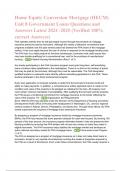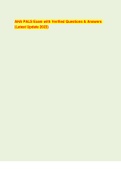Home Equity Conversion Mortgage (HECM)
Unit 8 Government Loans Questions and
Answers Latest 2024 -2025 (Verified 100%
correct Answers)
FHA operates entirely from its self-generated income through the proceeds of mortgage
insurance premiums paid by borrowers. Although the variety of attractive conventional loan
programs available over the past several years had lowered the FHA share of the mortgage
market, it has once again become the loan of choice in response to the mortgage lending crisis.
The FHA loan is a viable product for first-time homebuyers, borrowers with credit issues who
✅✅
may have trouble qualifying for a conventional loan, and for the purchase of manufactured
housing. - -Federal Housing Administration (fha) (1 of 2)
Any lender participating in the FHA insurance program must grant long-term, self-amortizing
loans at interest rates established in the marketplace. There is no limit on the number of points
that may be paid by the borrower, although they must be reasonable. The FHA designates
qualified lenders to underwrite loans directly without submitting applications to the FHA. These
lenders participate in the direct endorsement program.
Every loan application is reviewed carefully to determine the borrower's financial credit and
ability to make payments. In addition, a comprehensive written appraisal report is made on the
condition and value of the property to be pledged as collateral for the loan. All property must
meet certain minimum standards of acceptability. After qualifying the borrower and the property,
✅✅
the FHA issues a conditional commitment for mortgage insurance to the lender reflecting the
value of the property. Thi - -Organization and Requirements
Since 1965 the FHA has operated under the direction of the Department of Housing and Urban
Development (HUD) Office of Housing with headquarters in Washington, DC, and four regional
centers located in Atlanta, Denver, Philadelphia, and Santa Ana. Through these offices, the FHA
closely supervises the issuance of mortgage loans bearing its insurance.
By designing a program of mortgage insurance funded by mortgage insurance premiums
(MIPs), the FHA has reduced the down payment obstacle for cash-short buyers. By insuring 100
percent of the loan amount, the insurance program eliminates lenders' risks and preserves their
fiduciary profiles by ensuring that FHA lenders will not lose any money on loans they make to
✅✅
eligible borrowers. This FHA insurance helps stabilize the mortgage market and develops an
active national secondary market for FHA mortgage loans. - -Fha-insured Loan Program
(1 of 7)
The FHA is designed as a program of mortgage insurance so it does not make direct loans to
borrowers, except in very special circumstances involving the resale of properties acquired by
the FHA as a result of foreclosure. Even under these circumstances, the FHA usually requires a
,buyer of a foreclosed property to secure financing elsewhere and pay the FHA cash for the
property. Although FHA lenders are required to make every effort to offset a possible
foreclosure, in the event of a default and subsequent foreclosure, an insured lender will look to
the FHA to recover the unpaid balance of the mortgage and any costs involved in the
foreclosure action.
Title I
Title I, Section 2 provides insurance for loans to finance light or moderate rehabilitation of
properties, including the construction of nonresidential buildings. Loans on single-family homes
may be used for alterations, repairs, and site improvements. Loans on multifamily structures
may only be used for building alteration and repairs.
Maximum Loan Amount:
• Single family house—$25,000
• Manufactured house on permanent foundation—$25,090
• Manufactured house (classified as personal property)—$7,500
• Multifamily structure—average of $12,000 per unit up to $60,000
Maximum Loan Term:
• Single family house—20 years
• Manufactured house on permanent foundation—15 years
• Manufactured house (classified as personal property)—12 years
• Multifamily structure—20 years
✅✅
The interest rate is based on the common market rate and is negotiable between lender and
borrower. Any loan over $7,500 must be secured b - -Existing FHA Programs
The National Housing Act of 1934 provided for Title I and Title II insurance programs that are
still in use today, along with additional sections that have been added to reflect consumer needs
and market conditions. Changes to both Title I and Title II under the Housing and Economic
Recovery Act of 2008 (HERA) are reflected in the following material.
Manufactured homes must comply with the Model Manufactured Home Installation Standards
and all applicable state and local requirements governing the installation and construction of the
foundation system. The home must be installed on a suitable home site that meets local
standards and has adequate water supply and sewage disposal facilities. The site may be a
rental site in a manufactured home park meeting FHA guidelines or on an individual site owned
or leased by the borrower. Built-in appliances, equipment, and carpeting may also be financed.
Financing under Title I mortgage loans is provided by FHA-approved lenders. Credit is granted
based on the borrower's credit history and ability to repay the loan in regular monthly
installments. The up-front mortgage insurance premium may not exceed 2.25 percent with
✅✅
annual premiums of not more than 1 percent of the original insured obligation. -
-Manufactured Home Financing
, Since 1969, Title I, Section 2 provided insurance loans used for the purchase or refinancing of a
manufactured home, a developed lot on which to place a manufactured home, or a combination
of lot and home. Title I Manufactured Housing, as created under HERA, replaced the existing
program effective April 1, 2009, with new insurance coverage, premiums, and underwriting
guidelines, and loan limits. Highlights of the program currently in place are included here.
Maximum loan amounts as of 2011 are as follows:
• Manufactured home only—$69,678—20 year term
• Manufactured home lot—$23,226—15 year term
• Manufactured home and lot—$92,904—20 year term
• Multi-section manufactured home and lot—25 year term
The maximum loan limit for lot and combination loans may be as much as 85 percent higher in
designated high-cost areas. Loan limits may be adjusted annually based on manufactured
housing p
• Section 203(b)—Mortgage Insurance for One-Family to Four-Family Homes, including single
units in a condominium project
• Section 203(h)—Mortgage Insurance for Disaster Victims (100 percent financing available;
must file within one year after declaration of disaster)
• Section 203(k)—Mortgage Insurance for Purchase Plus Rehabilitation
• Section 203(n)—mortgage insurance for purchase of a unit in a cooperative housing project
• Section 221(d)(3) and (4)—mortgage insurance for multifamily rental or cooperative projects
• Section 223(e)—Mortgage Insurance for Older, Declining Areas
• Section 234(c)—Mortgage Insurance for Condominium Projects
• Section 251—Mortgage Insurance for Adjustable Rate Mortgages
• Section 255—Mortgage insurance for Home Equity Conversion Mortgage (reverse mortgage)
✅✅
• Section 811—Supportive Housing for Persons with Disabilities (provides direct funding to
nonprofit - -Existing FHA Programs
Title II
Title II originally established two basic mortgage insurance programs: Section 203 for one-family
to four-family homes, and Section 207 for multifamily projects such as rental housing,
manufactured home parks, and multifamily housing projects. Many additional programs have
been added over the years. The most frequently used Title II insurance programs are described
in more detail later in the unit. Changes made under the Housing and Economic Recovery Act
of 2008 (HERA) are reflected here:
Energy Efficient Mortgage (EEM)
The EEM can be used to finance the cost of adding energy-efficient features to new or existing
houses in conjunction with a Section 203(b) or 203(k) loan. It can also be used with the Section





